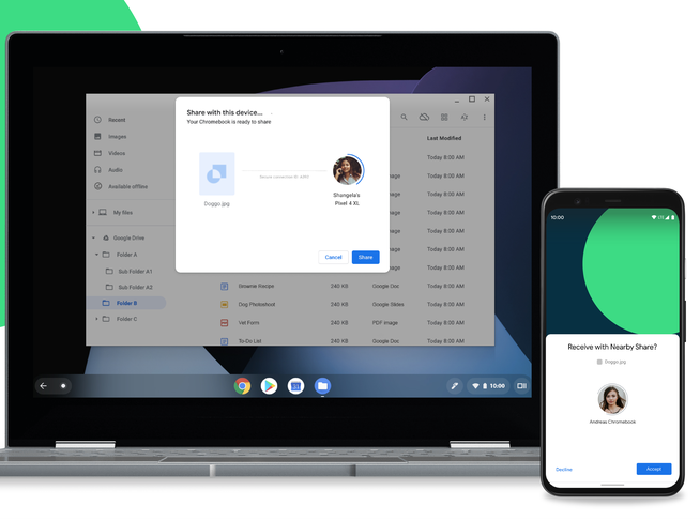

This one's still very early in development, so you can't try it out for yourself just yet. "That little tiny Phone Hub real estate - I would put a big 'Watch This Space' on it, because there’s a lot of stuff we can and will do there." "You’re just seeing the beginning," Google's Chrome OS product manager, engineering, and UX lead told me. Intriguing, no?įittingly, when I had the chance to chat with a couple o' Chrome OS bigwigs earlier this year, they hinted that such capabilities could be in the cards for the future.
#NEARBY SHARE GOOGLE CHROME ANDROID#
2: Phone mirroring What it's all aboutĪccording to some highly geeky signs in the open-source Chrome OS code, Google seems to be working on a feature that'd let you view your entire Android device's screen on your Chromebook, in real-time, anytime. Select "Nearby Share," and as long as your other device is set to be visible, it should show up as an option. If you want to send files from your Chromebook to another device, meanwhile, open up the system-level Files app, select the file you want, and then look for the share icon at the top of that window. On Android, look for the "Nearby Share" option in the standard system sharing interface, and you should see your Chrome OS device pop up as an option. You'll also find a toggle that'll make the device visible to anyone in your area immediately for a five-minute window.Įither way you go, once your Chromebook is visible, all you've gotta do is pick up your Android phone - or whatever device you want to use for the sharing - and share an image or any other type of file you want using the normal in-app sharing process.


There, you can fire the system up and then opt to keep your Chromebook visible to all of your contacts or just to a specific selection of people whenever your screen is on and the computer is unlocked. JRĬlick or tap that, and then you'll see the actual Nearby Share settings configuration tool. It also might actually say "Nearby visibil." instead of "Nearby visibility," since, erm, those four periods apparently take up way less space than the three letters they're replacing. You should see an option there called "Nearby visibility" (because going with clear and consistent branding across all environments would clearly be too much for Google to handle).
#NEARBY SHARE GOOGLE CHROME HOW TO#
How to find it nowĬlick or tap the clock area in the lower-right corner of your Chromebook's screen to open up the Chrome OS Quick Settings panel. It was officially announced and rolled out on the Chrome OS side of things just last week, so it's still got that fresh 'n' steamy new-feature smell. Our first new Chrome OS feature is the long-under-development Nearby Share system for sending and receiving files wirelessly between multiple Chromebooks or Chromebooks and Android devices. 1: Wireless file sharing What it's all about Two nearby devices will simply have to use the option built into the Android system when one device hit the “share” button and choose “Nearby Share.” The receiving device will have to accept request from sending device to receive the file.Chrome OS feature No. In Nearby Share, you will use WiFi Direct technology to make transfers. How will devices connect by Nearby Share?

Similarly, with Google’s Nearby Share, Android users can send files between two Android devices by bringing them closer together. We have gone through several different phases when it comes to file transfer technology, from primitive infrared to instant messaging apps to Bluetooth.Īs we know, iOS devices have a function called AirDrop, which allows you to exchange files between two iPhone, simply by bringing them closer together. 2 How will devices connect by Nearby Share?įile sharing is the most common thing in the world these days.


 0 kommentar(er)
0 kommentar(er)
